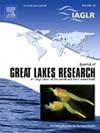Spatial and inter-annual variation in the Lake Superior offshore zooplankton community
IF 2.5
3区 环境科学与生态学
Q3 ENVIRONMENTAL SCIENCES
引用次数: 0
Abstract
Lake Superior’s offshore zooplankton community is commonly considered spatially homogeneous and relatively invariant, and thus often referenced as a baseline oligotrophic zooplankton community for the Great Lakes. However, zooplankton biomass can indeed exhibit substantial variability in Lake Superior on finer spatial and temporal scales, but this is not well documented in the literature. We used long-term monitoring data generated by the Environmental Protection Agency’s Great Lakes Biology Monitoring Program from 1997 to 2018 to investigate offshore zooplankton community structure during summer stratification. Both cluster analysis and non-metric multidimensional scaling ordination were used to examine zooplankton spatial patterns in relation to environmental variables. In addition, we used modeled surface current projections for the weeks prior to sampling events to assess the potential importance of horizontal transport in shaping the offshore zooplankton community. We found that although calanoid copepods consistently dominated the community, the relative contribution of cladocerans to total zooplankton biomass was variable. Cluster analysis often singled out three stations, two north of Isle Royale and one offshore of the Pic River, that typically had both higher chlorophyll-a concentrations and higher cladoceran biomass than most others. Analysis of surface current projections suggested horizontal transport of zooplankton could occur from stations with high cladoceran biomass, possibly driving more widespread shifts in the offshore community than expected. Continued assessment of connections between physical and biological variables is important to anticipate food web responses to future stressors, such as climate-driven changes to temperature and circulation.
苏必利尔湖近海浮游动物群落的空间和年际变化
苏必利尔湖的近海浮游动物群落通常被认为是空间同质和相对不变的,因此通常被认为是五大湖的低营养浮游动物群落的基线。然而,苏必利尔湖的浮游动物生物量确实可以在更精细的时空尺度上表现出实质性的变化,但这在文献中没有很好的记载。我们使用了1997年至2018年美国环境保护局大湖生物监测计划产生的长期监测数据,调查了夏季分层期间的近海浮游动物群落结构。采用聚类分析和非度量多维尺度排序方法研究了浮游动物空间格局与环境变量的关系。此外,我们使用采样事件前几周的模拟表面水流预测来评估水平运输在塑造近海浮游动物群落中的潜在重要性。研究发现,虽然类鱿鱼桡足类在群落中占主导地位,但枝海类对浮游动物总生物量的相对贡献是可变的。聚类分析通常会挑出三个站点,两个在皇家岛北部,一个在皮克河近海,与其他站点相比,这些站点通常具有更高的叶绿素-a浓度和更高的枝海生物量。对地表水流预测的分析表明,浮游动物的水平迁移可能发生在具有高枝海洋生物量的站点,这可能会导致近海群落比预期更广泛的转移。持续评估物理和生物变量之间的联系对于预测食物网对未来压力源(如气候驱动的温度和循环变化)的反应非常重要。
本文章由计算机程序翻译,如有差异,请以英文原文为准。
求助全文
约1分钟内获得全文
求助全文
来源期刊

Journal of Great Lakes Research
生物-海洋与淡水生物学
CiteScore
5.10
自引率
13.60%
发文量
178
审稿时长
6 months
期刊介绍:
Published six times per year, the Journal of Great Lakes Research is multidisciplinary in its coverage, publishing manuscripts on a wide range of theoretical and applied topics in the natural science fields of biology, chemistry, physics, geology, as well as social sciences of the large lakes of the world and their watersheds. Large lakes generally are considered as those lakes which have a mean surface area of >500 km2 (see Herdendorf, C.E. 1982. Large lakes of the world. J. Great Lakes Res. 8:379-412, for examples), although smaller lakes may be considered, especially if they are very deep. We also welcome contributions on saline lakes and research on estuarine waters where the results have application to large lakes.
 求助内容:
求助内容: 应助结果提醒方式:
应助结果提醒方式:


